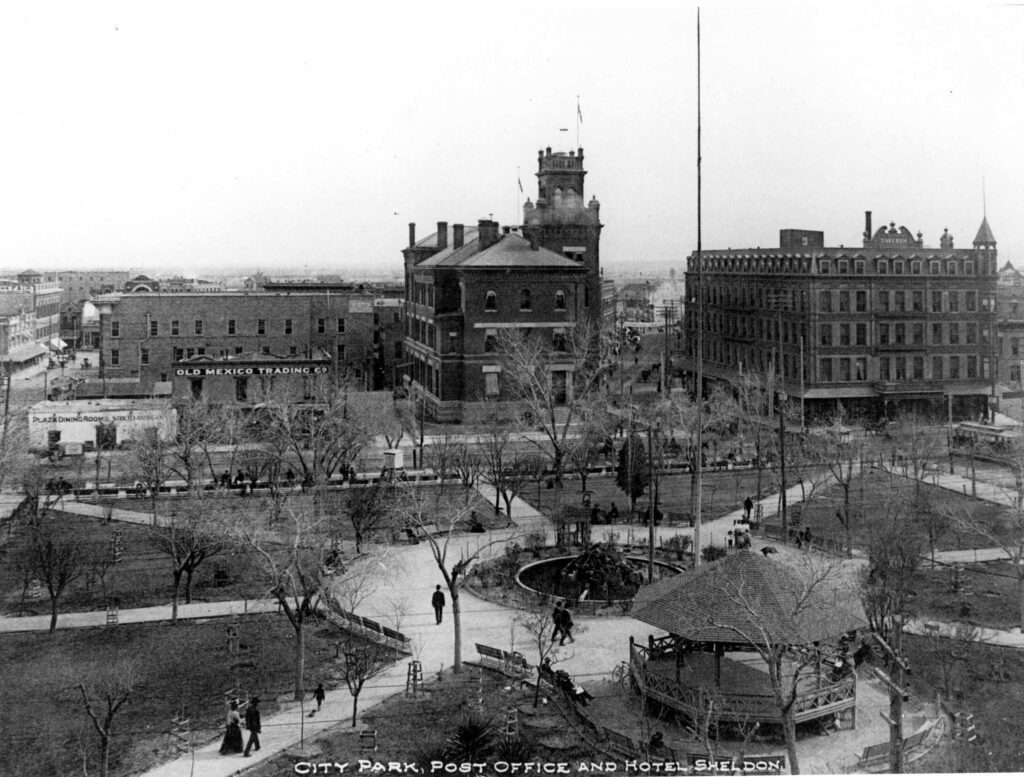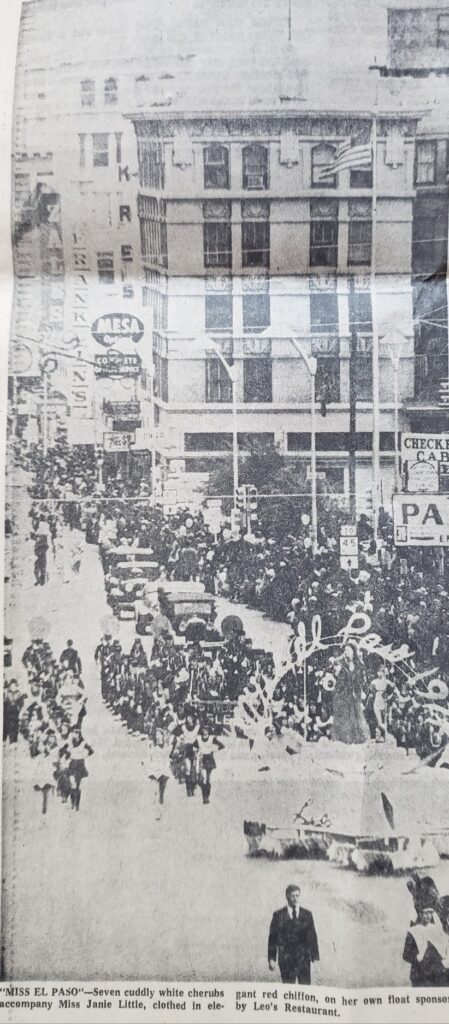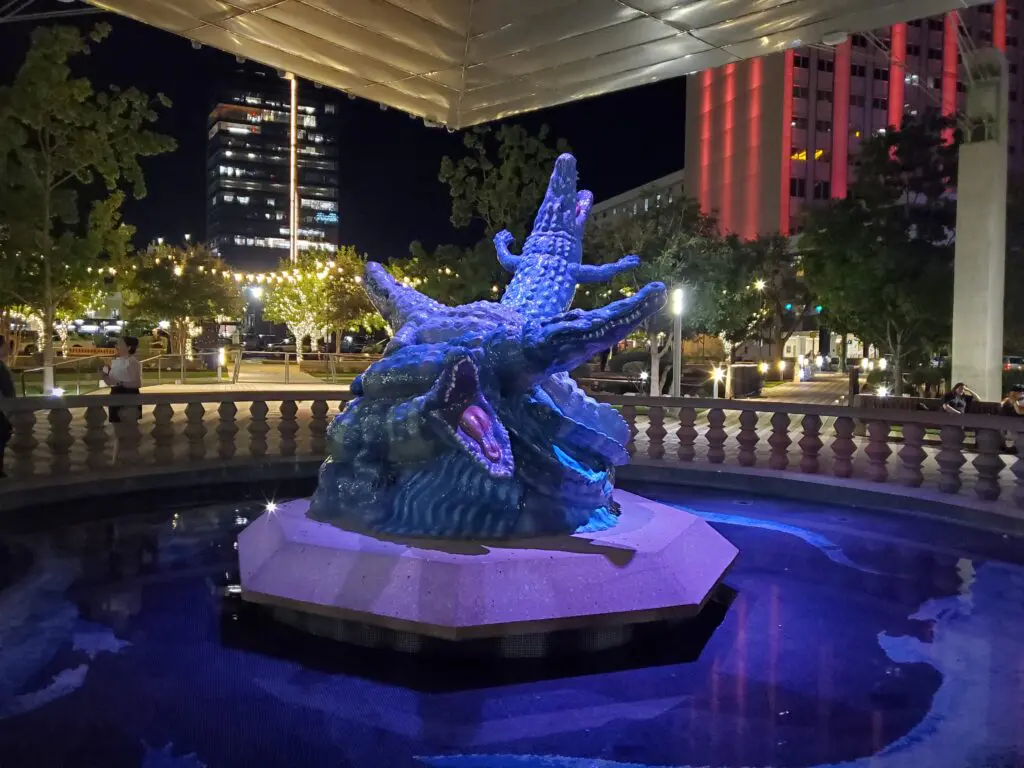(Photo El Paso Historical Society)
Recently I returned to El Paso to visit my past—my classmates, Northeast El Paso’s Milagro Hills where I grew up, the Upper Valley where I last lived in the city, and, of course, Guyrex landmarks important to my newest book, The Pink Dress, Memoir of a Guyrex Girl.
A pleasant surprise was my residence during this journey down memory lane, a trip I shared with childhood friends. Together we stayed in the penthouse rooms on top of El Paso’s historic, art-deco Plaza Hotel (the Hilton, 1929), supposedly in the rooms that Nicky Hilton’s young wife Elizabeth Taylor occupied.
That was a novelty, but so was discovering members of the Scorpions, a rock band from the last century (see, I am showing my age!) who were performing at UTEP on one night of our stay. Their rooms were six floors below ours. A man, wearing a Scorpions t-shirt and bushy hair flowing sideways and down his back, politely exchanged places with us on an elevator. I snidely commented to my friends that an old rocker had shown up to attend the Scorpians’ concert. Little did I know, the fellow with grizzled hair was their drummer Mikkey Dees.
Below our 17th floor rooms, my friends and I could see historic landmarks from our past. There stood the Plaza Theater (1930) where, instead of sitting below the starry night-sky garden, we had sat under a balcony, so kids from rival high schools couldn’t spit on us from above. In front of our wine-colored, velveteen seats, our choir teacher Richard Hawley performed before weekend matinees on a grand Wurlitzer organ that arose from an orchestra pit in front of the stage.
There was also the Mills Building (1911), a renowned architect Henry Trost design where the White House Department Store once occupied. My girlfriends and I reminisced the times we saved up to shop in the downtown store known for high-end clothing. A few of us were fortunate to get jobs there, which meant discounted clothes sales.
But it was what was across the street from the Plaza Hotel, Plaza Theater, and Mills Building that brought back memories, tinged with smells, sights, and sounds that flashed across my brain. San Jacinto Plaza.
Most southwest, Spanish-colonial towns and cities began with a plaza, often near a church. And this would be true for El Paso’s sister city Juárez, with its missions and churches. Perhaps because of the Mexican city’s earlier birth (1659) as El Paso del Norte on the south side of the Rio Grande, and El Paso’s later established recognition on the north side of the river after the Treaty of Hidalgo (1848), a main plaza was delayed in its construction. But I’m just theorizing.

What I do know is that in 1881, two acres were purchased to be used as a bona fide town square, framed by Mills, Oregon, Main, and Mesa streets. By 1882, a new plaza offered an open area in the middle with sidewalks, trees and benches spreading out from the center. The plaza earned its unique name in 1889, when in the middle of a sundial design at its center, an alligator pond was added. El Pasoans now called the plaza—La Plaza de Los Lagartos or Alligator Park.
No, though alligators occupy much of the south, east, and even central parts of Texas, they are not native to the high desert of El Paso! The first alligator came from Louisiana. In March 1889, a plaza park manager announced to El Paso papers that he was expecting a baby alligator to arrive soon. When the reptile arrived four months later, a crowd of El Pasoans came to see the baby “disport himself in foreign waters.” Soon, more alligators arrived, and they had fans.
The alligators became the central attraction at San Jacinto Plaza, the plaza renamed in 1903 after a famous battle for Texas independence from Mexico. Early visitors would rest on the wall surrounding the pond, watch the alligators, and chat about the day’s current events. On occasion, troops paraded around the square, artists exhibited their paintings, and holiday festivities abounded. The reptiles quickly became a staple of El Paso culture. At one time the pond contained seven alligators.
An online newspaper search reveals that in late summer 1952, Minnie, a 59-year-old female alligator, laid a total of three eggs aside the pond. Spectators were delighted when they saw the protective mother-alligator spring to life and lunge toward park employees who were cleaning the pond. The eggs never hatched.
Also in 1952, pranksters left a 10-foot San Jacinto Plaza alligator named Oscar inside Texas Western College (now UTEP) geology Professor Howard Quinn’s office. It thrashed around, damaging office furniture, “showing no sympathy for higher education.” A park commissioner stated, “Oscar went to college but he flunked out. Guess he was too old to learn.” Oscar was 60 years old. Still, newspapers reported that having alligators was said to be more dangerous for the alligators than for the pranksters.
Months later, Oscar was found dead at the bottom of the pond, the result of internal injuries after vandals threw him back into the water. El Pasoan Myrtle Price donated two alligators named Jack and Jill to take Oscar’s place, a pair who arrived in a cigar box, also from Louisiana. These two alligators are likely some of the ones I saw when I was a kid growing up in El Paso. They joined four other alligators, all between 60 and 70 years old.
Another prank occurred in 1956 after college students dumped another San Jacinto Plaza alligator into the Texas Western College swimming pool, right before an intramural swim meet. The park department advisor this time quipped, “It’s almost an annual occurrence. In another year or so, those alligators will know their own way home!”
Sally, one of the first alligators placed in the pond, was the object of a weight-guessing contest in 1958. The El Paso Herald Post shared that Sally was 8-feet-8-inches long, causing a flurry of letters to reach alligator experts across the country. Contenders for a $100 prize and a round-trip to Mexico City asked for scientific opinions regarding the reptile’s possible weight. One alligator expert refused to respond to the letters, saying, “Alligators are like people. Some are fat and some are thin. Some are hard and tough, and some soft and blubbery.”
Other competitors tried to make assessments on their own. To help them in their weight estimates, park officials painted a pink arrow on Sally’s head to help single her out from her pond-mates. Complicating people’s guesses, however, was the fact that Sally temporarily gained ten pounds immediately after feeding on ten pounds of horse meat. After a month of excitement, one estimator out of 10,000 entries hit Sally’s weight exactly—240 pounds and 2 ounces!
My remembrance of the old plaza is mainly during the 1960s when it was a hub for boarding city buses and taxicabs that had replaced horse-drawn carriages. We retrieved our Mexican maid there each week and returned her to the bus stop at the end of the day. And every time we attended a movie at the Plaza Theater, we begged our parents to first visit the alligators.
My last memory of the plaza was on a freezing day in January 1972, captured in an El Paso Times’ newspaper photograph. Wearing a three-quarters-length mink coat over my evening gown, I stand atop a Miss El Paso float with a portion of the Sun Carnival Parade on North Mesa Street. A man I hadn’t known took stock of my frozen situation and taking the coat from his wife, tossed it up to me. Behind me looms the five-story Banner Building, also designed by Henry Trost and beyond it, the art-deco Kress building and the Plaza Hotel. But the reader’s eye catches what is behind my float in the photograph—a procession of 1910s and 1920s cars follows, frozen in time, while to my left, crowds throng within San Jacinto Plaza, decked out in Christmas attire

My childhood friends shared their memories. They claimed the alligators smelled, but I don’t recall that sensory memory. My brain is full of sidewalk streetlights, park benches sticky with the day’s brown paper-bag lunches and sugary Mexican Coca Cola, people of all stripes milling around— Juareños and El Pasoans alike—and the pond’s murky surface. My childish curiosity consisted of waiting impatiently to see the alligators stick their gnarled snouts out of the gnat-covered water. When they did, we gleefully searched for any food tidbit to toss at them. This was probably against the rules.
Unfortunately, other passersby hurled rocks at the animals and burned them with cigarettes to get them to move.
The alligators were finally relocated to the El Paso Zoo in 1965 after Chama and Zal—a reference to the Chamizal border agreement—were stoned to death and another had a spike driven through its left eye. The alligators were briefly returned to the plaza in 1972 only to be removed once again in 1974 because of vandals. The pond was permanently removed shortly thereafter.
Today, a commemorative statue of the alligators sits in a central fountain to honor the 80-year history of alligators in the old plaza. Los Lagartos Fountain, Fountain with Alligators.
There are no smells. The water is clean and clear. Not a piece of trash or sticky syrup covers the pavers or new benches in the sterile, modern plaza. My friends and I, though, could remember, imagining the old smells, sights, and sounds of San Jacinto Plaza as we gazed into a new alligator pond with a central sculpture. Reflected in a kaleidoscope of colors, three frozen alligators, struggle to stick their snouts up high, mouths gaped open.

Ahhh what memories we all had of this once living curiosity for The Pass of the North. The renewed Plaza and stony Logartos a sweet reminder of days past.
While you were freezing your “nalgas” on that float, I was marching, playing a frozen french horn, in an old wool band uniform.
Afterwards, some of us went to the Plaza to watch the matinee, I think it was “Live and Let Die”!
Thank you for this! So you were warmer, but scratchier? You and Diana’s comment remind me that I need to write a blog on the Plaza Theater. So much there for us and generations before.
So glad you were on this journey with me!
What memories this brought back for me. It’s interesting how all of us raised in El Paso, have such vivid memories of a bygone era. Thank you for your story.
Thank you, Maxine! My husband just pointed out that he doesn’t have memories like this having been raised elsewhere in Texas. It’s El Paso’s history that makes all the difference.
Seeing the Plaza theater brought back memories of my very first date with my high school boyfriend. Paint your wagon was playing that night, then afterwards we drove over to Juarez for a Fred’s sandwich. I also remembered that my mom’s first job at 17 was at the Plaza Theater at the ticket counter out front. Brought back so many memories walking through downtown.
What beautiful memories you share! Also the reminder that we could drive across the Santa Fe Bridge to the Juarez strip, a safer time.
Being a native El Pasoan and a Hotel Dieu baby, I remember downtown El Paso as a thriving hub of commerce, entertainment, fine and local dining, shopping with the San Jacinto Plaza being the heart of downtown. The Plaza Theatre is an old friend and I’m delighted the El Paso Community Foundation through hard work, donations from patrons, and the support of El Pasoans, the contributing Mayors and City Council saved it. Downtown El Paso is slowly returning to a thriving, attractive community. While visiting there a few weeks ago, there were no signs of graffiti, panhandlers, or ruffians. I walked through the San Jacinto Plaza with my dearest friends during the day and evening and felt safe. My memories of San Jacinto Plaza, the ‘gators, the buses, the people who congregated there are part of my memory DNA. Thank you for writing about this blessed place.
You are so welcome. I hope to include stories about this in an upcoming newsletter. Anyone who wants to be on the email list can email me at jane@janelittlebotkin.com